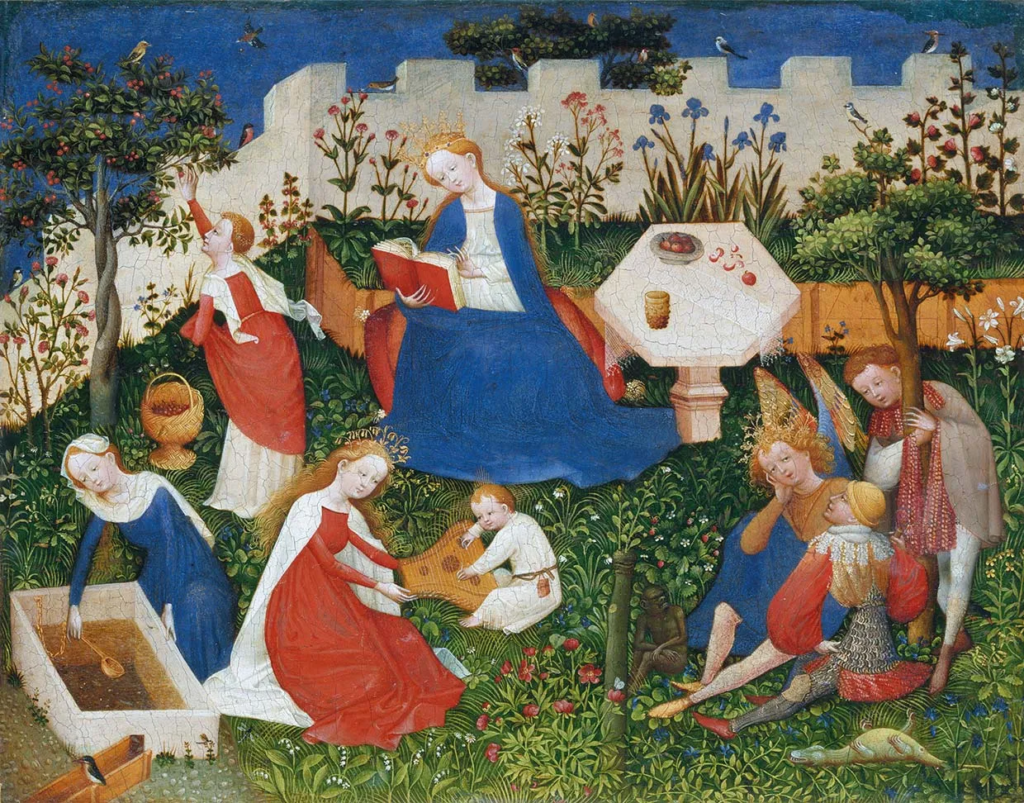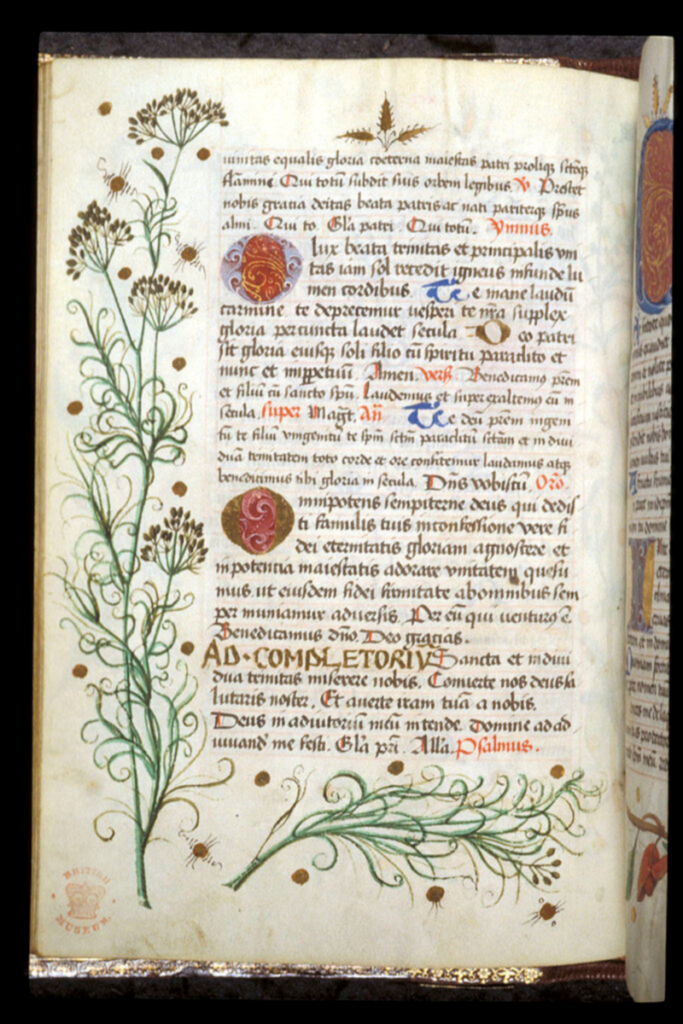
Medicinal gardens were commonly grown in Medieval monasteries used both for treating and for teaching.
In the thirteenth century, Albertus Magnus wrote about crafting a medieval pleasure garden and encouraged the planting of “every sweet-smelling herb, all sorts of flowers, a great diversity of medicinal and scented herbs, not only to delight by their perfume, but to refresh the sight with the variety of flowers, and to cause many forms of admiration in those who look at them.“
Borage (Borago officinalis)
Family Boraginaceae

Borage is also known as the Starflower. In medieval times, borage tea was given to competitors in tournaments to inspire courage and flowers were infused in wine as a tonic to banish melancholy.
A popular vegetable and salad herb. Flowers start pink then turn blue, bees love them! Plant near strawberry plants for extra pollination. Add flowers to salads or to ice cubes to brighten up drinks.
Sow 2 – 5 mm deep direct into the growing position or in seedling trays. Best planted in a group to support each other. Full sun or part shade. Sub -Tropical: April – Sept, Temperate: Feb – Nov, Cool: Sept – Jan. Protect from frost. Germination 14 – 21 days. Will often self-seed each year. When the mature plants start to look leggy they can be used to add minerals as compost enricher or add leaves to a bucket and fill it with water, use a stone or brick to hold the plant material down. Leave for 2 weeks then mix one part of the borage fertiliser to 10 parts water.
Fennel (Foeniculum vulgare)
Family Umbellifers

Regarded as a valuable addition to a Medieval Garden as a culinary and medicinal plant. Both the seed and plant were used. Seeds were used as a digestive aid, to relieve colic and to reduce the appetite. Fennel seeds were chewed fennel during worship services to protect against evil influences. Fennel loves warm conditions. Sowing direct where fennel is to grow. Sow the seeds into fine moist soil about 1cm deep, three or four seeds every 25-30cm. Avoid root disturbance if possible. Can also be grown in containers of multipurpose compost. Keep well-watered.
Hyssop (Hyssopus officinalis)
Family Lamiaceae
Medieval Monks used hyssop to spice soups and stews. Only one or two small fresh leaves, finely chopped. In Medieval times was used medicinally for many ills. Culpepper’s Herbal, written in the 17 century noted, ‘It is an excellent medicine for the quinsy, or swellings in the throat, to wash and gargle it. It was used for respiratory troubles and even “purging gross humours by stool and killing worms in the belly”.
Hyssop as a garden herb has much to offer – the beautiful blue flowers attract bees, butterflies and beneficial insects. They can be planted as a companion to increase pollination of other crops. Beekeepers found the bees produced sweet, aromatic honey when they feed on Hyssop.
Flowers late Summer. Hyssop loves full sun and is drought tolerant. Avoid over-watering. 14 – 21 days germination. Sow after the threat of frost is over.
Parsley (Petroselinum crispum var neapolitanum)
Family Apiaceae
‘Petersilie’ – Parsley was popular as popular then as it is now, used in cooking, salats (Medieval term for Salads), as a garnish and as a tea.
Hildegard of Bingen (1098-1179) recorded many of the plants she regarded as important medicine. She recommended parsley compresses for arthritis and parsley boiled in wine for many other medicinal purposes.
Flat leaf Parsley is a biannual and may self-seed in the right conditions. Grow in full sun or part shade. Sow Spring to Autumn in all climates. 30cm apart, Sow depth 3mm, press down and barely cover. Germination 21-28 days
Pot marigold (Calendula officinalis)
Family Asteraceae
Known also as “Golde”, the golden-coloured flower was often featured in art, literature, and poetry. It has a long history of culinary and medicinal use. Petals were used for cooking in Medieval times to add colour to the dish, hence the name Pot Marigold. Commonly used for minor skin conditions and wound healing. Petals can be used to brighten salads and teas. Add petals into a bath with a handful of Epsom salts for a soothing and relaxing soak.
Cool season hardy annual. When to plant; Temperate; Spring and Autumn, Subtropical: Late Summer to Late Autumn, Tropical: April to August. Full sun. Sowing direct or into seedling trays: 30cm apart. Germination 10 -14 days. Will often self-seed each year.
Sage (Salvia officinalis)
Family Laminaceae
Sage was historically considered to be something of a cure-all by medieval monks and physicians. Used in cooking and infused in wine and as a tea. For the best flavour collect the leaves before flowering, late morning or early evening when the aromatic oils are concentrated in the leaves. Grows well in well-drained soil and warm weather. Germination: 21 – 28 days.
Snapdragon (Antirrhinum majus)
Family Plantaginaceae
They are cool-season plants and will bloom in cooler weather. To grow add the fine seeds to the soil, do not cover. Spray only with a mist. Germination 8-14 days. Quite hardy once established.
In Medieval Europe, Snapdragons were planted near the Castle gates to act as guardians and protectors. The flowers of the Snapdragon look like the face of a dragon and its mouth will open and close when it is squeezed. Women believed that using infusions of boiled snapdragon on their faces would keep them looking young ad beautiful.
The flowers are edible and can be added to salads, and used as a garnish to brighten cheese boards and grazing platters.
Yarrow (Achillea millefolium)

Family Asteraceae
In medieval times it was known as Knight’s Milfoil, Bloodwort, Wound Wort, Staunchgrass, or Sanguinary, traditionally used to reduce bleeding and heal wounds.
Yarrow is a perennial plant. The leaves can be used as a compost accelerator. The flowers attract beneficial insects to the garden, so this is another great plant to have as a companion to fruiting crops
Sow when the temperature is 18 – 24 c and keep moist with a mist spray until germination in around 14 – 28 days. Grow in full sun or part shade. Cut back hard after flowering to encourage plant growth, alternatively, you can allow some flowers to go to seed for propagation. Another way to reproduce plants is to divide clumps in Autumn.
“From little things, big things grow“

If you have any questions about growing your seeds and looking after your plants feel free to send me a message anytime.
The information regarding traditional herbal use is for historical educational purposes only. This information NOT intended or implied to be a substitute for professional health and medical advice or treatment.
Research sources
Fundamentals of Pharmacognosy and Phytotherapy 2nd ed, M. Heinrich, J. Barnes, S. Gibbons, E. Williamson 2013
A History of Herbal Plants, R. LeStrange, 1977
Principles and Practice of Phytotherapy 2nd ed, Kerry Bone, Simon Mills, 2013
Phytotherapy Desk Reference, Michael Thomsen, 2020
Traditional Medicine, Steve B Kayne, Pharmaceutical Press, 2009
National Library of the Netherlands
http://www.bl.uk/catalogues/illuminatedmanuscripts/ILLUMIN.ASP?Size=mid&IllID=9943
http://www.complete-herbal.com/culpepper/completeherbalindex.htm
http://medievalcookery.com/spices/spices.html?Hyssop
